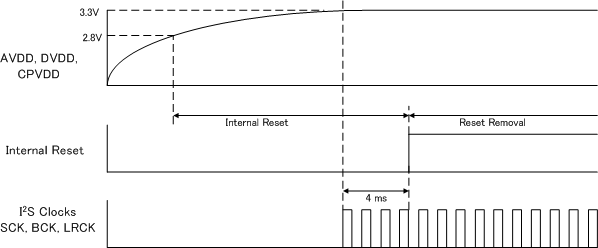JAJSGF2C August 2012 – October 2018 PCM5121 , PCM5122
PRODUCTION DATA.
- 1 特長
- 2 アプリケーション
- 3 概要
- 4 改訂履歴
- 5 概要(続き)
- 6 Device Comparison
- 7 Pin Configuration and Functions
- 8 Specifications
-
9 Detailed Description
- 9.1 Overview
- 9.2 Functional Block Diagram
- 9.3
Feature Description
- 9.3.1 Terminology
- 9.3.2 Audio Data Interface
- 9.3.3 XSMT Pin (Soft Mute / Soft Un-Mute)
- 9.3.4 Audio Processing
- 9.3.5 DAC Outputs
- 9.3.6
Reset and System Clock Functions
- 9.3.6.1 Clocking Overview
- 9.3.6.2 Clock Slave Mode With Master and System Clock (SCK) Input (4 Wire I2S)
- 9.3.6.3 Clock Slave Mode With BCK PLL to Generate Internal Clocks (3-Wire PCM)
- 9.3.6.4 Clock Generation Using the PLL
- 9.3.6.5 PLL Calculation
- 9.3.6.6 Clock Master Mode from Audio Rate Master Clock
- 9.3.6.7 Clock Master from a Non-Audio Rate Master Clock
- 9.4 Device Functional Modes
- 9.5 Programming
- 10Application and Implementation
- 11Power Supply Recommendations
- 12Layout
- 13Register Maps
- 14デバイスおよびドキュメントのサポート
- 15メカニカル、パッケージ、および注文情報
パッケージ・オプション
メカニカル・データ(パッケージ|ピン)
- PW|28
サーマルパッド・メカニカル・データ
- PW|28
発注情報
11.4.1 Power-On Reset, DVDD 3.3-V Supply
The PCM512x includes a power-on reset function, as shown in Figure 83. With VDD > 2.8 V, the power-on reset function is enabled. After the initialization period, the PCM512x is set to its default reset state. Analog output will begin ramping after valid data has been passing through the device for the given group delay given by the digital interpolation filter selected.
 Figure 83. Power-On Reset Timing, DVDD = 3.3 V
Figure 83. Power-On Reset Timing, DVDD = 3.3 V